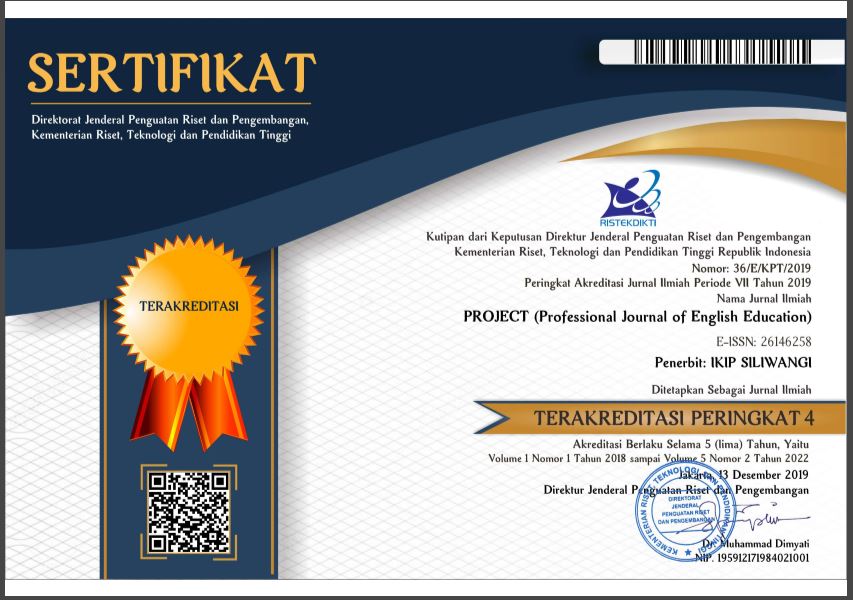STUDENTS’ ENGAGEMENT IN NARROW LISTENING: A CASE OF AN EXTENSIVE LISTENING COURSE
Abstract
This article explores the implementation of Narrow Listening (NL) in an Extensive Listening (EL) course at a private English Education Department in Indonesia, addressing a gap in research regarding student engagement. Guided by Krashen's theory of input and repetitive listening practices, the study examines how NL can aid learners in achieving fluency and automaticity. Employing a case study approach, data were collected through observations of 42 multilingual students aged 18 to 19 during their first semester in the 2023/2024 academic year. Analysis revealed themes of both positive and negative behavioral, emotional, and cognitive engagement among students. While many demonstrated increased motivation and comprehension, some expressed anxiety and discomfort with certain learning tasks. The findings suggest that NL can significantly improve listening skills, boost student motivation, and facilitate a conducive learning environment, ultimately leading to better language acquisition outcomes. This study contributes valuable insights for educators aiming to enhance best practices in tertiary English education in Indonesia.
References
Anderson, J. R. (1990). Cognitive Psychology and Its Implications: Third Edition. New York: Freeman.
Chang, A. C-S. (2016). Teaching L2 listening: In and outside the classroom. In Renandya, W., & Handoyo, P. W. (Eds.), English language teaching today (pp. 111-125). Switzerland: Spinger International Publishing.
Dewaele, J.-M. (2015). On emotions in foreign language learning and use. The Language Teacher, 39(3), 13–15. Doi: https://doi.org/10.37546/JALTTLT3 9.3-3
Dupuy, B. C. (1999). Narrow listening: An alternative way to develop and enhance listening comprehension in students of French as a foreign language. System, 27(3), 351–361. Doi: https://doi.org/10.1016/S0346-251X(99)00030-5
Fredricks, J. A., Blumenfeld, P. C., & Paris, A. (2004). School engagement: Potential of the concept: State of the evidence. Review of Educational Research, 74, 59-119.
Hutapea, S. C., Adnan, A., & Marlina, L. (2020). The correlation between EFL students listening motivation with listening anxiety in Intermediate Listening class. Journal of English Language Teaching, 9(3), 520-530. Doi: https://doi.org/10.24036/jelt.v9i4.110228
Krashen, S. D. (1996). The case for narrow listening. System, 24(1), 97-100. Doi: https://doi.org/10.1016/0346-251X(95)00054-N
Mackey, A. & Gass, S. M. (2012). Research Methods in Second Language Acquisition: A Practical Guide. Malden, MA: Wiley-Blackwell.
Nugroho, A., Zamzami, M. R. A., & Ukhrowiyah, N. F. (2020). Language input, learning environment, and motivation of a successful EFL learner. Journal on English as a Foreign Language, 10(1), 45-67. Doi: https://doi.org/10.23971/ jefl.v10i1.1511
Opdenakker, M.-C., & Van Damme, J. (2006). Teacher characteristics and teaching styles as effectiveness enhancing factors of classroom practice. Teaching and Teacher Education, 22(1), 1–21. Doi: https://doi.org/10.1016/j.tate.2005. 07.008
Renandya, W. A., & Farrell, T. (2011). Teacher, the tape is too fast! Extensive listening in ELT. ELT Journal, 65(1), 52-59. Doi: http://dx.doi.org/10.1093/elt/ccq015
Vo, Y. (2013). Developing extensive listening for EFL learners using internet resources. Hawaii Pacific University TESOL Working Papers Series 11, 29-51. Retrieved from: https://www.hpu.edu/research-publications/tesol-working-papers/2013/02_YenVo2013 .pdf
Yeh, C-C. (2013). An investigation of a podcast learning project for EL. Language Education in Asia, 4(2), 135-149. Doi: http://dx.doi.org/10.5746/LEiA/ 13/V4/I2/A04/Yeh
Downloads
Published
Issue
Section
License

This work is licensed under a Creative Commons Attribution-ShareAlike 4.0 International License.




